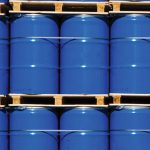Caustic soda or sodium hydroxide is a white solid substance with the chemical formula of NaOH and it is resulted from the process of electrolysis of sodium chloride soluble in the electrolytic vessels. It is called caustic soda because it is highly corrosive in nature. It is available in many forms in the industry, and the most common forms are caustic soda flakes and caustic soda pearls. Pure Caustic soda is a colorless crystalline solid that melts at 318 °C without decomposition. It is highly soluble in water, with a lower solubility in polar solvents such as ethanol and methanol.
Similar to the hydration of sulfuric acid, dissolution of caustic soda flakes in water is a highly exothermic reaction where a large amount of heat is released, posing a threat to safety through the possibility of splashing. The resulting solution is usually colorless and odorless. As with other alkaline solutions, it feels slippery with skin contact due to the process of saponification that occurs between NaOH and natural skin oils.
Caustic soda is industrially produced as a 50% solution by variations of the electrolytic chloralkali process. Chlorine gas is also produced in this process. Solid sodium hydroxide is obtained from this solution by the evaporation of water. Solid sodium hydroxide is most commonly sold as flakes, pills, and cast blocks.
| Caustic Soda Flakes – Purity-97-2 | |||
| Characteristic | Unit | Normal Range (Grade A) |
Test Method |
|---|---|---|---|
| Purity as NaOH | Wt % | 97± 2 | JIS K 1200 |
| Carbonates as Na2CO3 | Wt % | 1 Max | JIS K 1200 |
| Chlorides as NaCL | Wt % | 0.06 Max | ASTM E 291 |
| Sulfates as Na2SO4 | Wt % | 0.01 Max | ASTM E 291 |
| Silicates as SiO2 | Wt % | 0.02 Max | IS 252 |
| Aluminum as Al2O3 | Wt- ppm | 20 Max | ISO 10566 |
| Iron as Fe2O3 | Wt- ppm | 30 Max | ASTM E 291 |
| Insoluble in Water | Wt% | 0.1 Max | BSI 6075 |
| Arsenic as AS2O3 | Wt- ppm | 2 Max | IS 9831 |
| Caustic Soda Flakes – Purity-98 | ||
| Characteristic | Unit | Test Result |
|---|---|---|
| Purity as NaOH | %w/w | 98 Min |
| Carbonates as Na2CO3 | %w/w | 1 Max |
| Chlorides as NaCL | ppm | 100 |
| Irons as Fe2O3 | ppm | 8 |
| Hg | – | ND* |
| Insoluble Materials | %w/w | <0.1 |
| Heavy(As,Pb,Hg) | – | ND* |
| Caustic Soda Flakes – Purity-99.05 | ||||
| Characteristic | Unit | Test Result | Accepting Limit | Test Method |
|---|---|---|---|---|
| Purity as NaOH | Wt % | 99.05 | 97 Min | JIS K 1200 |
| Carbonates as Na2CO3 | Wt % | 0.24 | 1 Max | JIS K 1200 |
| Chlorides as NaCL | Wt % | 0.02 | 0.06 Max | ASTM E 291 |
| Sulfates as Na2SO4 | Wt % | 0.0045 | 0.01 Max | ASTM E 291 |
| Silicates as SiO2 | Wt % | 0.005 | 0.02 Max | IS 252 |
| Aluminum as Al2O3 | mg/Kg | <20 | 20 Max | ISO 10566 |
| Heavy Metals as Pb | mg/Kg | <20 | 20 Max | ISIRI – 364 |
| Iron as Fe2O3 | mg/Kg | 9.98 | 30 Max | ASTM E 291 |
| Insoluble in Water | W% | 0.03 | 0.1 Max | BSI 6075 |
| Copper as Cu | mg/Kg | <2 | 2 Max | ISIRI – 364 |
| Manganese as Mn | mg/Kg | <1 | 1 Max | ISIRI – 364 |
Packing
- Bulk
- Flexi Tank
- Drum



